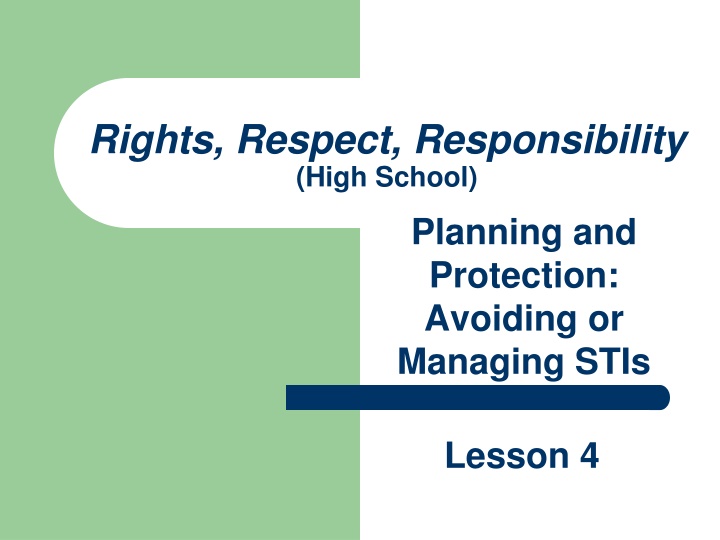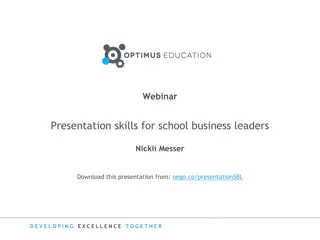
STIs and HIV in High School: Lesson 4 Activities
Discover the importance of rights, respect, and responsibility in managing STIs and HIV in high school. Engage in interactive class activities to learn about sexual health and protection. Explore topics related to STIs, HIV, and safe practices in a fun and educational setting.
Download Presentation

Please find below an Image/Link to download the presentation.
The content on the website is provided AS IS for your information and personal use only. It may not be sold, licensed, or shared on other websites without obtaining consent from the author. If you encounter any issues during the download, it is possible that the publisher has removed the file from their server.
You are allowed to download the files provided on this website for personal or commercial use, subject to the condition that they are used lawfully. All files are the property of their respective owners.
The content on the website is provided AS IS for your information and personal use only. It may not be sold, licensed, or shared on other websites without obtaining consent from the author.
E N D
Presentation Transcript
Rights, Respect, Responsibility (High School) Planning and Protection: Avoiding or Managing STIs Lesson 4
Reminders Let s review our ground rules and procedures as a class. Remember to use the Anonymous Question Box!
STIs and HIV What does STI mean? Sexually Transmitted Infection What about HIV? Human Immunodeficiency Virus STIs and STDs mean the same thing and refer to the same group of bacteria, viruses, and other organisms that can be passed from one infected person to another during sexual contact. HIV is the virus that can lead to AIDS.
Class Activity: Index Card Game Everyone will have 1 index card. Find a partner. I am going to give you a topic to discuss with this person. You have 2 minutes to chat about this topic: Topic 1: What are your 3 favorite movies and why? Thank your partner and write the name of the person you have been chatting with on a line on your index card. 1. 2. 3. 4.
Class Activity: Index Card Game 5. Find a new partner: Topic 2: If money were no option, and you could travel anywhere in the world, where would you go? Why? 6. Thank your partner and write your new partner s name on your index card. 7. One more partner: Topic 3: If you could have any three super powers, what would they be and why? 8. Thank your partner, write their name on your card, and return to your seat.
Class Activity: Index Card Game For the purposes of this activity only, let s say those weren t just conversations, but sexual encounters. Turn your card over to the unlined side. In one of the corners, you might see a lightly written letter. If you have an S, please stand up. These S people (for this activity only) have an STI. Even though they look and feel fine and had no idea they had an STI.
Class Activity: Index Card Game Look to see if you have one of the S people s signatures on your card. If you do, STAND UP. Of those standing, if you have an A on your card, you may sit down. This means you chose to stay abstinent. You did no-risk intimate things together or nothing sexual at all. Therefore you did a great job, the best job in fact, of protecting yourself from STIs or HIV. If you have a C on your card, you may also sit down. This means you used condoms or other latex barriers. So you were at very low risk for STIs or HIV (or pregnancy if you were with an opposite sex partner).
Class Activity: Index Card Game If you have a P on your card, it means that if one person in the relationship can get pregnant, they were on the pill, but that s the only method you used. Great job protecting yourself against pregnancy, if that was a risk. But the pill offers NO protection against STIs or HIV. So you have to remain standing. If you have a U on your card, that means you did not use any condoms or latex barriers during your sexual encounter, which means it was unprotected. This is very risky for an STI, HIV, or possibly pregnancy. Remain standing.
Class Activity: Index Card Game If you have a blank card, it means you were using alcohol or drugs during the sexual encounter. You don t remember what happened, including whether or not you used a condom or other latex barrier. So you need to remain standing.
Class Discussion: Index Card Game How many people were standing the very first time. i.e., how many people had an S on their cards? By the end of the activity, how many people are standing? These are the people who had unprotected sex with the original S group. What was it like to do this activity? Why? What did you notice about who got to sit down, and who had to remain standing? Why? What does the number of people who were standing at the end of the activity tell you?
Planning and Protection Abstinence is the safest and only 100% effective choice for eliminating STI/HIV risk. 1) Condoms and other latex barriers are a must for reducing STI/HIV risk. 2) Talking with your partner is key before having any kind of sex. 3) Contraceptive methods like the pill are great for pregnancy prevention, but they do not protect against STIs or HIV. 4) Get tested for STIs and HIV if you are having sex and ask your partner(s) to get tested, too. 5)
Protect Yourself CONDOMS: One source of free condoms is our School Nurse. The nurse will give you a plain looking package containing condoms, condom-compatible lubricant, and information on how to use the condoms correctly. Your conversation will be private and confidential. VACCINES: There are two STIs for which you can be vaccinated: Hepatitis B and HPV (Human Papilloma Virus). In California, minors 12 years and older can consent to these vaccines without their parents permission, if they wish to.
Class Activity: Jingles! 1. Get into 5 groups. 2. Each group will get 1 of the 5 Planning and Protection statements (slide 11). 3. Your group should create a commercial, jingle, slogan, or logo to market the statement.
Class Activity: Jingles! 4. Present to the class. 5. Provide feedback: What is strong about each presentation? What could be improved?
Summary STIs and HIV are a very real part of our world. 1 in 4 teens will end up with an STI once they are engaging in some kind of sex. 21% of new cases of HIV in the U.S. are contracted by young people. Everyone has a responsibility to know how to practice ways to reduce their chances of contracting an STI or HIV.
Homework 1. Read through the instructions of the STI/HIV Investigative Reporting worksheet. 2. This assignment involves interviewing people about their knowledge of STIs. 3. Part 3 requires that you have a conversation with a parent or other trusted adult about this topic.

















